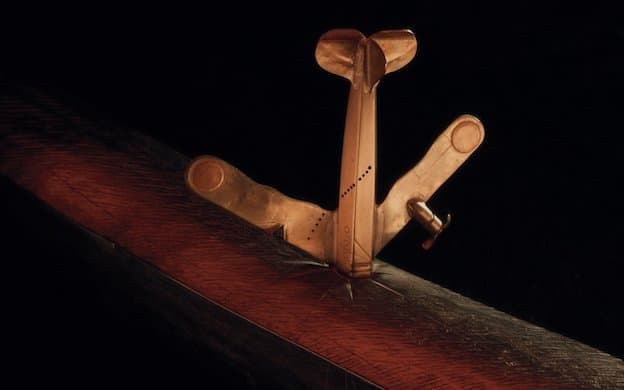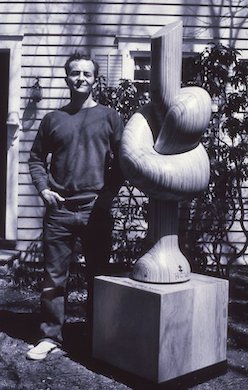Director Leslie Buchbinder Pulls Off a 3-D Documentary About a Little-Known Artist
The idea does make sense: H.C. Westermann wasn’t only three-dimensional but kaleidoscopic, a cigar-chomping contrarian with an aesthete’s taste for form and a carpenter’s love of a finely grained chunk of wood.

The true star of “Westermann: Memorial to the Idea of Man If He Was an Idea” is not its subject, the artist H.C. Westermann (1922-81), but its director, Leslie Buchbinder. A writer, director, and producer based at Chicago, Ms. Buchbinder got it into her head to make a 3-D documentary.
As a genre, it’s not unheard of, but such an endeavor is typically devoted to the far reaches of the cosmos, the depths of the earth, or the sweep of the oceans — arenas in which space is paramount. But a stereoscopic picture devoted to an ornery sculptor whose work is, by and large, the purview of specialists? Either the director doesn’t know her limitations or she’s given to quixotic ventures.
As it turns out, Ms. Buchbinder’s movie can be dovetailed into the latter category. “Memorial to the Idea of Man If He Was an Idea” is a gambit that paid off. Making a 3-D film about an artist working in three dimensions is a no-brainer, I suppose, but Westermann’s work isn’t as expressly sculptural as that of Bernini, say, or Richard Serra. As an individual, though, Westermann wasn’t only three-dimensional but kaleidoscopic, a cigar-chomping contrarian with an aesthete’s taste for form and a carpenter’s love of a finely grained chunk of wood. That, and he walked on his hands. A lot.
Born Horace Clifford Westermann, “Cliff,” as his friends came to know him, evinced an interest in making things at an early age. After graduating from high school, he worked as a logger in the Pacific Northwest and then joined the Marines at the onset of World War II. Having been stationed as an anti-aircraft gunner on the USS Enterprise, Westermann experienced Japanese kamikaze attacks and participated in significant military operations, including the Battle of Midway. His time in combat would later be memorialized in a suite of sardonic effigies known as the “Death Ships.”

After the war, Westermann worked as part of a two-man acrobatic act and took classes at the Chicago Art Institute. Testing his tendency toward adventure, Westermann would join the conflict in Korea: “Well, anyway the Korean War came along & I wanted to see if I was still a coward–I was!”
After divorcing his first wife, a showgirl he married on the quick in 1945, Westermann met and later wed Joanna Beall, a painter who had studied at Yale with Josef Albers. When Beall’s parents fronted the couple a parcel of land, Westermann, a man whose carpentry skills were formidable, went about building their dream house and studio at bucolic Brookfield Center, Connecticut.
All the while he continued to make art, crafting absurdist totems that tapped into a wild streak of independence that is an unmistakable component of the American spirit. Although his work was represented by Allan Frumkin Gallery, a Chicago-based gallery with an outpost at Manhattan, Westermann kept the art world at arm’s length, preferring the solitude of the woodshop to the fripperies of the gallery circuit.
His strongest kinship was with artists who stood apart from the mainstream: Alberto Giacometti, Joseph Cornell, and Elie Nadelman. Which isn’t to say that he didn’t answer the door when opportunity came knocking. The first person to buy his art was Mies van der Rohe, the pioneering Modernist architect. His work was later featured in “New Images of Man,” the seminal 1959 exhibition at the Museum of Modern Art. Westermann achieved his own kind of fame.
There’s the Beatles, for instance. During the course of Ms. Buchbinder’s film we get to know the artist’s sister, Martha Westermann Renner. Taking account of the surroundings in which she’s being interviewed, you can’t help but notice a commemorative plate featuring the cover of “Sgt. Pepper’s Lonely Hearts Club Band” placed directly in the foreground. Among the personages shunted into that iconic image is Ciff himself, or, rather, that distinctive forehead: the majority of Westermann’s face is covered by the plume of George Harrison’s hat. Is it too much to imagine that he took a perverse pride in this fillip?
One could fault Ms. Buchbinder for trying too hard to meld Westermann and his idiosyncrasies with the 3-D format, but, overall, she locates a rationale for the gimmick and weaves it well into the artist’s life and aesthetic.
Ed Harris does the voiceover as Westermann, and the soundtrack is as idiosyncratic as it is homespun, featuring, as it does, Laurie Anderson, the Kronos Quartet, alt-country musician Terry Allen, and, especially fine, the keening music of Tomeka Reid. If “Memorial to the Idea of Man If He Was an Idea” doesn’t give us a full accounting of the sculptures, it is, all the same, a gateway into a singular man’s hardwon and often very funny vision.

